Unit 7 Topic 2 I’m not sure whether I can cook it well.SectionD课件 (共20张PPT)
文档属性
| 名称 | Unit 7 Topic 2 I’m not sure whether I can cook it well.SectionD课件 (共20张PPT) |

|
|
| 格式 | zip | ||
| 文件大小 | 4.5MB | ||
| 资源类型 | 教案 | ||
| 版本资源 | 仁爱科普版 | ||
| 科目 | 英语 | ||
| 更新时间 | 2022-04-06 19:19:28 | ||
图片预览


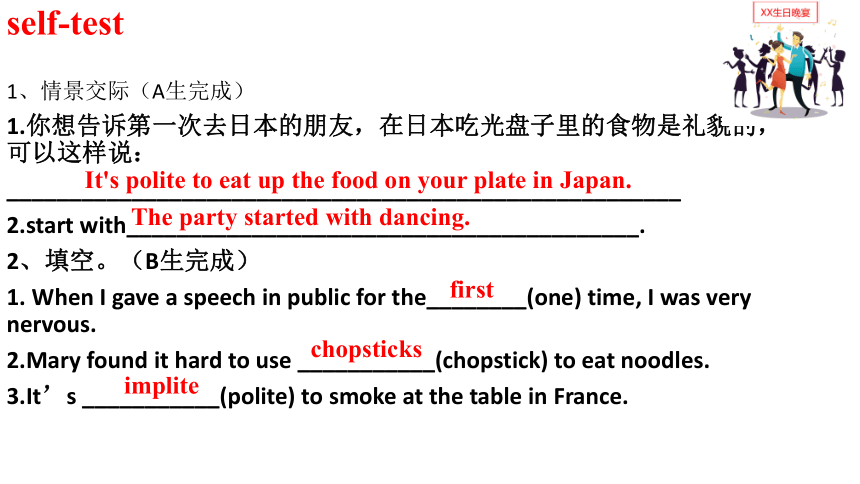


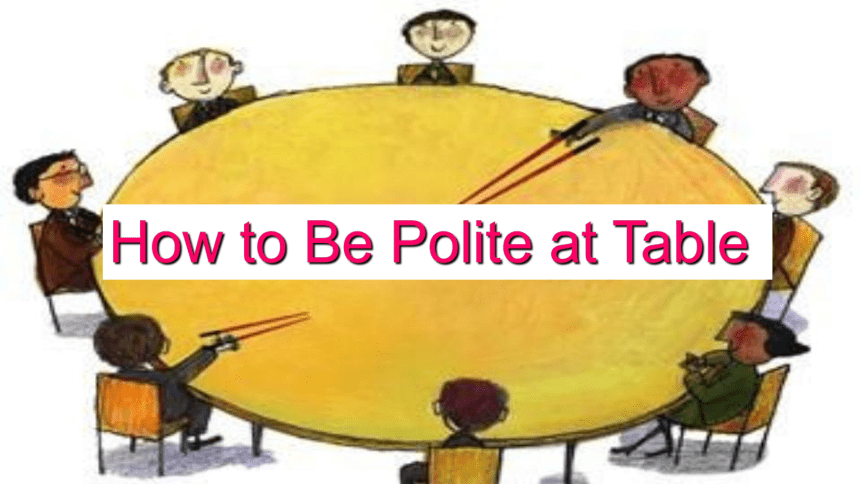
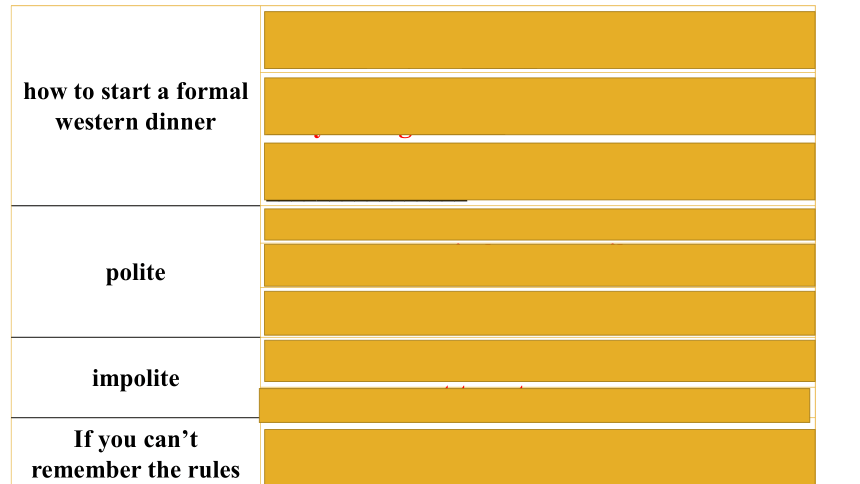
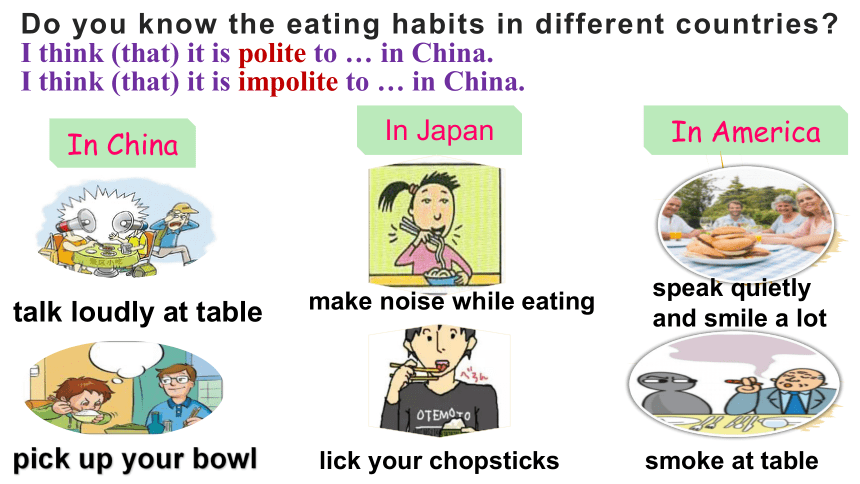
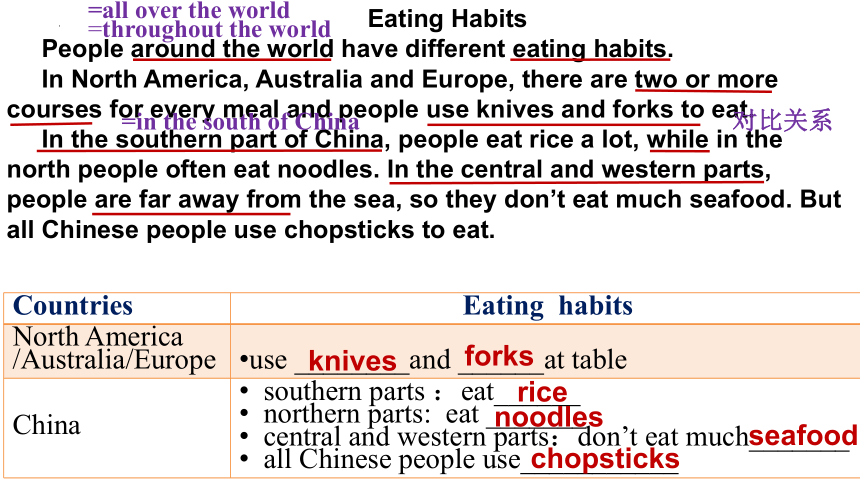
文档简介
(共20张PPT)
Unit 7 Topic 2
Section D
1.第一次______________ 2.餐桌礼仪______________
3.吃光____________ 4.以..开始______________
5.为..干杯______________ 6.举杯____________
7.用..吃______________ 8.指着_____________
9.喝太多____________ 10.喝一小口____________
11.使用某物做某事____________ 12.不需要...____________
13.记得不要做某事____________ 14.坐在桌子旁边____________
1.如果你第一次参加正式的西餐宴会,你最好要了解西方的餐桌礼仪。
2.记得不要喝太多。
3.吃光盘子里的食物是礼貌的,因此拿的食物不要超过你需要的份量。
4.也许你不知道在吃饭时大声说话是否有礼貌
5.当你向某人敬酒时,你最好举起酒杯只喝一小口。
If you go to a formal western dinner party for the first time, you'd
better know about western table manners.
Remember not to drink too much.
It's polite to eat up the food on your plate, so don't take more food than you need.
Maybe you don't know whether it's polite or not to speak loudly at the table.
When you drink to someone, you'd better raise your cup or glass and take only a little.
for the first time
table manners
eat up
start with
drink to sb./sth
raise your cup
eat with...
point at sb.
drink too much
take a little
use sth. to do
there is no need
remember not to do sth.
sit at the table
self-test
1、情景交际(A生完成)
1.你想告诉第一次去日本的朋友,在日本吃光盘子里的食物是礼貌的,可以这样说:
______________________________________________________
2.start with_________________________________________.
2、填空。(B生完成)
1. When I gave a speech in public for the________(one) time, I was very nervous.
2.Mary found it hard to use ___________(chopstick) to eat noodles.
3.It’s ___________(polite) to smoke at the table in France.
It's polite to eat up the food on your plate in Japan.
The party started with dancing.
first
chopsticks
implite
1.
掌握本课4个单词,8个短语。
2.
复习由whether/if引导的宾语从句
3.
复习单音节副词比较级
Set the goal
1.南方的_______
2.['s :fu:d]_______
3.[p k]________
4.sausage_________
[ s s d ] n. 香肠
seafood n. 海鲜,海味
pick v. 采,摘,拾起,采集,挑选
southern adj. [ s ( )n]
Self-study
How to Be Polite at Table
how to start a formal western dinner 1.When you sit down at the table, take your ________ on your ______.
2.When you start dining, you should keep the fork ___________________.
3.If you use your knife, then put the fork ________________.
polite 1.________ the food on your plate.
2.Try to speak _______ and ______ a lot.
3.When drinking to someone, take ___________.
impolite 1.Don’t take _____ food than _________.
2.Remember ___________ too much.
If you can’t remember the rules
Just do _________________.
napkin
lap
in your right hand
in your left hand
Eat up
quietly
smile
only a little
more
you need
not to eat
as other people do
Do you know the eating habits in different countries
In China
talk loudly at table
pick up your bowl
In Japan
make noise while eating
lick your chopsticks
In America
speak quietly and smile a lot
smoke at table
I think (that) it is polite to … in China.
I think (that) it is impolite to … in China.
Eating Habits
People around the world have different eating habits.
In North America, Australia and Europe, there are two or more courses for every meal and people use knives and forks to eat.
In the southern part of China, people eat rice a lot, while in the north people often eat noodles. In the central and western parts, people are far away from the sea, so they don’t eat much seafood. But all Chinese people use chopsticks to eat.
Countries Eating habits
North America /Australia/Europe
use ________and ______at table
China southern parts :eat______
northern parts: eat _______
central and western parts:don’t eat much_______
all Chinese people use___________
knives
forks
rice
noodles
seafood
chopsticks
=all over the world
=throughout the world
=in the south of China
对比关系
India
Thailand
Korea
eat with a spoon and a fork
use their fingers to pick up the food
use spoons or chopsticks
use no knives
In parts of India, people use their fingers to pick up the food.
In Thailand,people eat with a spoon and a fork and they don't use knives at all.
In Korea, people use spoons or chopsticks to eat, but it is not polite to use both of them at the same time.
not polite=impolite
1.世界各地______________ 2.饮食习惯______________
3.捡起;获得____________ 4.在中国南方______________
5.在中、西部______________
6.远离____________7.同时______________ 8.葱______________ 3.小小翻译官1.全世界的人们有不同的饮食习惯。_________________________________________________.2.康康到达地最早。______________________________________________________________.3.你知道在法国餐桌上吃饭时吸烟是否礼貌吗?________________________________________________________________ 4.但是我不确定是否能煮得好。_____________________________________________________.
around the world
eating habits
pick up
In the southern part of China
In the central and western parts
far away from
at the same time
People around the world have different eating habits.
green onion
Kangkang arrives earliest.
Do you know whether or not it's impolite to smoke during a meal in France
But I am not sure whether / if I can cook it well
Object Clauses(Ⅱ)
But I'm not sure whether/if I can cook it well.
Can you tell me if/whether it's polite to eat with your arms or elbows on the table in America
Do you know whether or not it's impolite to smoke during a meal in France
Grammar
总结:if /whether 引导宾语从句时,翻译为“_________”,通常两者可以_________,但是当与or not 搭配时,只能用________。
if / whether 引导的宾语从句通常表达一般疑问的意思。
是否
互相替换
whether
Review
Functions
First ... Second ... Next ... Then ... After that ... Finally ...
Well done!
Would you mind if we learn to make it from you
Of course not.
Remember not to drink too much.
Comparative and Superlative Degrees of Adverbs(Ⅰ)
Jane arrives early. Michael arrives earlier.
Kangkang arrives earliest.
副词的比较级和最高级
Chicken soup is very delicious,
3
Look at the pictures and write a passage about how to cook chicken soup.
cut up
wash
put...into
boil
add salt,
green onions
ready,
enjoy
and it’s good for our health.
Now let’s cook it together.
First, cut up chicken.
Next, wash the chicken .
Then,put it into a deep pot 70% -80% full of water.
After that, boil the chicken for about 2 hours.
Finally, add some salt, green onions and so on.
Now the chicken soup is ready and you can enjoy it.
二、填空题。(B生完成)1. Tracy got to the classroom __________(early) of all the students this morning.2.Li Hong comes from the ____________(south) part of China. She like eating rice.3.It’s hard for children to sit ____________(quiet) in the classroom for a long time.
一、情景交际(A生完成)1.你想夸朋友事情办得真棒,可以这样说:___________________________________2. eat,with__________________________________。
Well done!
The boy eats the noodles with chopsticks.
earliest
southern
quietly
—Can you tell me if it’s polite to eat with your arms or elbows on the table in America
— Yes, I can. It’s impolite.
— Do you know whether or not it’s impolite to smoke during a meal in France
— Yes, I do. It’s impolite.
— We know people use a spoon and a fork to eat in Thailand. Do you know whether they use knives
— Yes, I do. They don’t use them.
— I know Indians eat with their right hands. I don’t know if there’s no need for knives, forks or chopsticks.
— No, there’s no need.
Match the pictures with the conversations.Then practice in pairs.
n.肘,肘部
A
B
C
D
C
B
A
D
Discuss eating customs in different countries, using object clauses.
Example:
Is it polite to point at people with chopsticks in China
A: I want to know whether/if it is polite to point at people with chopsticks in China.
B: I don't think that it is polite to point at people with chopsticks in China.
point at sb.指向某人
宾语从句用陈述语序
it 作形式主语
1. Is it polite to eat soup very quietly in most African countries
A:I want to know whether/if it is polite to...
B:I think that it is polite to.....
2. Can people smoke during a meal in France
A:I want to know whether/ if it is polite to smoke....
B:I think that it's impolite to smoke...
3. Will people leave as soon as they finish eating in western countries
4. Do Americans eat food like chicken legs with their fingers
5. Does a formal western dinner always start with a small dish
n.手指
finish doing sth
1.
掌握本课4个单词,8个短语。
2.
复习由whether/if引导的宾语从句
3.
复习单音节副词比较级
Summary
Unit 7 Topic 2
Section D
1.第一次______________ 2.餐桌礼仪______________
3.吃光____________ 4.以..开始______________
5.为..干杯______________ 6.举杯____________
7.用..吃______________ 8.指着_____________
9.喝太多____________ 10.喝一小口____________
11.使用某物做某事____________ 12.不需要...____________
13.记得不要做某事____________ 14.坐在桌子旁边____________
1.如果你第一次参加正式的西餐宴会,你最好要了解西方的餐桌礼仪。
2.记得不要喝太多。
3.吃光盘子里的食物是礼貌的,因此拿的食物不要超过你需要的份量。
4.也许你不知道在吃饭时大声说话是否有礼貌
5.当你向某人敬酒时,你最好举起酒杯只喝一小口。
If you go to a formal western dinner party for the first time, you'd
better know about western table manners.
Remember not to drink too much.
It's polite to eat up the food on your plate, so don't take more food than you need.
Maybe you don't know whether it's polite or not to speak loudly at the table.
When you drink to someone, you'd better raise your cup or glass and take only a little.
for the first time
table manners
eat up
start with
drink to sb./sth
raise your cup
eat with...
point at sb.
drink too much
take a little
use sth. to do
there is no need
remember not to do sth.
sit at the table
self-test
1、情景交际(A生完成)
1.你想告诉第一次去日本的朋友,在日本吃光盘子里的食物是礼貌的,可以这样说:
______________________________________________________
2.start with_________________________________________.
2、填空。(B生完成)
1. When I gave a speech in public for the________(one) time, I was very nervous.
2.Mary found it hard to use ___________(chopstick) to eat noodles.
3.It’s ___________(polite) to smoke at the table in France.
It's polite to eat up the food on your plate in Japan.
The party started with dancing.
first
chopsticks
implite
1.
掌握本课4个单词,8个短语。
2.
复习由whether/if引导的宾语从句
3.
复习单音节副词比较级
Set the goal
1.南方的_______
2.['s :fu:d]_______
3.[p k]________
4.sausage_________
[ s s d ] n. 香肠
seafood n. 海鲜,海味
pick v. 采,摘,拾起,采集,挑选
southern adj. [ s ( )n]
Self-study
How to Be Polite at Table
how to start a formal western dinner 1.When you sit down at the table, take your ________ on your ______.
2.When you start dining, you should keep the fork ___________________.
3.If you use your knife, then put the fork ________________.
polite 1.________ the food on your plate.
2.Try to speak _______ and ______ a lot.
3.When drinking to someone, take ___________.
impolite 1.Don’t take _____ food than _________.
2.Remember ___________ too much.
If you can’t remember the rules
Just do _________________.
napkin
lap
in your right hand
in your left hand
Eat up
quietly
smile
only a little
more
you need
not to eat
as other people do
Do you know the eating habits in different countries
In China
talk loudly at table
pick up your bowl
In Japan
make noise while eating
lick your chopsticks
In America
speak quietly and smile a lot
smoke at table
I think (that) it is polite to … in China.
I think (that) it is impolite to … in China.
Eating Habits
People around the world have different eating habits.
In North America, Australia and Europe, there are two or more courses for every meal and people use knives and forks to eat.
In the southern part of China, people eat rice a lot, while in the north people often eat noodles. In the central and western parts, people are far away from the sea, so they don’t eat much seafood. But all Chinese people use chopsticks to eat.
Countries Eating habits
North America /Australia/Europe
use ________and ______at table
China southern parts :eat______
northern parts: eat _______
central and western parts:don’t eat much_______
all Chinese people use___________
knives
forks
rice
noodles
seafood
chopsticks
=all over the world
=throughout the world
=in the south of China
对比关系
India
Thailand
Korea
eat with a spoon and a fork
use their fingers to pick up the food
use spoons or chopsticks
use no knives
In parts of India, people use their fingers to pick up the food.
In Thailand,people eat with a spoon and a fork and they don't use knives at all.
In Korea, people use spoons or chopsticks to eat, but it is not polite to use both of them at the same time.
not polite=impolite
1.世界各地______________ 2.饮食习惯______________
3.捡起;获得____________ 4.在中国南方______________
5.在中、西部______________
6.远离____________7.同时______________ 8.葱______________ 3.小小翻译官1.全世界的人们有不同的饮食习惯。_________________________________________________.2.康康到达地最早。______________________________________________________________.3.你知道在法国餐桌上吃饭时吸烟是否礼貌吗?________________________________________________________________ 4.但是我不确定是否能煮得好。_____________________________________________________.
around the world
eating habits
pick up
In the southern part of China
In the central and western parts
far away from
at the same time
People around the world have different eating habits.
green onion
Kangkang arrives earliest.
Do you know whether or not it's impolite to smoke during a meal in France
But I am not sure whether / if I can cook it well
Object Clauses(Ⅱ)
But I'm not sure whether/if I can cook it well.
Can you tell me if/whether it's polite to eat with your arms or elbows on the table in America
Do you know whether or not it's impolite to smoke during a meal in France
Grammar
总结:if /whether 引导宾语从句时,翻译为“_________”,通常两者可以_________,但是当与or not 搭配时,只能用________。
if / whether 引导的宾语从句通常表达一般疑问的意思。
是否
互相替换
whether
Review
Functions
First ... Second ... Next ... Then ... After that ... Finally ...
Well done!
Would you mind if we learn to make it from you
Of course not.
Remember not to drink too much.
Comparative and Superlative Degrees of Adverbs(Ⅰ)
Jane arrives early. Michael arrives earlier.
Kangkang arrives earliest.
副词的比较级和最高级
Chicken soup is very delicious,
3
Look at the pictures and write a passage about how to cook chicken soup.
cut up
wash
put...into
boil
add salt,
green onions
ready,
enjoy
and it’s good for our health.
Now let’s cook it together.
First, cut up chicken.
Next, wash the chicken .
Then,put it into a deep pot 70% -80% full of water.
After that, boil the chicken for about 2 hours.
Finally, add some salt, green onions and so on.
Now the chicken soup is ready and you can enjoy it.
二、填空题。(B生完成)1. Tracy got to the classroom __________(early) of all the students this morning.2.Li Hong comes from the ____________(south) part of China. She like eating rice.3.It’s hard for children to sit ____________(quiet) in the classroom for a long time.
一、情景交际(A生完成)1.你想夸朋友事情办得真棒,可以这样说:___________________________________2. eat,with__________________________________。
Well done!
The boy eats the noodles with chopsticks.
earliest
southern
quietly
—Can you tell me if it’s polite to eat with your arms or elbows on the table in America
— Yes, I can. It’s impolite.
— Do you know whether or not it’s impolite to smoke during a meal in France
— Yes, I do. It’s impolite.
— We know people use a spoon and a fork to eat in Thailand. Do you know whether they use knives
— Yes, I do. They don’t use them.
— I know Indians eat with their right hands. I don’t know if there’s no need for knives, forks or chopsticks.
— No, there’s no need.
Match the pictures with the conversations.Then practice in pairs.
n.肘,肘部
A
B
C
D
C
B
A
D
Discuss eating customs in different countries, using object clauses.
Example:
Is it polite to point at people with chopsticks in China
A: I want to know whether/if it is polite to point at people with chopsticks in China.
B: I don't think that it is polite to point at people with chopsticks in China.
point at sb.指向某人
宾语从句用陈述语序
it 作形式主语
1. Is it polite to eat soup very quietly in most African countries
A:I want to know whether/if it is polite to...
B:I think that it is polite to.....
2. Can people smoke during a meal in France
A:I want to know whether/ if it is polite to smoke....
B:I think that it's impolite to smoke...
3. Will people leave as soon as they finish eating in western countries
4. Do Americans eat food like chicken legs with their fingers
5. Does a formal western dinner always start with a small dish
n.手指
finish doing sth
1.
掌握本课4个单词,8个短语。
2.
复习由whether/if引导的宾语从句
3.
复习单音节副词比较级
Summary
同课章节目录
- Unit 5 Feeling excited
- Topic 1 You look excited
- Topic 2 I’m feeling better now.
- Topic 3 Many things can affect our feelings.
- Unit 6 Enjoying Cycling
- Topic 1 We're going on a three-day visit to Mount
- Topic 2 How about exploring Tian’anmen Square?
- Topic 3 Bicycle riding is good exercise.
- Unit 7 Food festival
- Topic 1 We’re preparing for a food festival.
- Topic 2 I’m not sure whether I can cook it well.
- Topic 3 I Cooked the Most Successfully
- Unit 8 Our Clothes
- Topic 1 We will have a class fashion show.
- Topic 2 We can design our own uniforms.
- Topic 3 He said the fashion show was wonderful.
